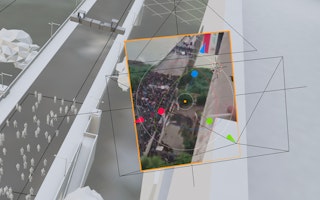OSI Stories: Open Access to Scientific Research—Sharing Information, Saving Lives
By Melissa Hagemann
The following is an updated version of an article that originally appeared in the Open Society Institute 2006 Annual Report.
AIDS deaths, thousands of them, punctuate Mphatso Nguluwe’s memories of her nursing career at the Ekwendeni Hospital in the northern end of Malawi. The AIDS catastrophe has already reduced the average life expectancy in her country to about 37 years.
And Nguluwe—a single woman who, at age 38, laughs about being old—is marching at the forefront of the local effort to prevent the epidemic from worsening. Her job is to instruct students at Ekwendeni’s nursing school. She is desperate to teach them the best methods available for treating people living with the HIV virus and practical steps HIV-positive mothers can take to reduce the risk of spreading the virus to their infants. She knows that for Malawi’s people, some of the poorest in the world, this is a matter of life and death.
Nguluwe does what she can to keep up with the latest medical research on HIV transmission. Her closest access point is an Internet café about 20 kilometers from home. So, once a month or so, she makes the trip in a minibus down a pot-holed asphalt road.
If the Internet lines are working on the day she visits, Nguluwe combs the websites of medical journals from the developed world and pores over abstracts of peer-reviewed articles. The full journal articles Nguluwe needs are just a “click-here-to-purchase” away. But a single article costs more than an average monthly wage in Malawi, and the subscription prices are so high that looking at them is infuriating. So the only way Nguluwe can get the critical information contained in these articles is to rely on a network of friends living abroad. This, she says, can take months or years.
Without the best information, “millions more will die.”
“It is frustrating,” she says. “HIV and AIDS have hit us in Africa the hardest, and it is up to us to learn what we can to fight the disease. If we can’t obtain the best information, we can’t succeed in our struggle and millions more will die. Some researchers have even come here from abroad to work, gone home, and published their findings; but articles they’ve written cannot be accessed here.”
Moreover, she says, people have been infected with HIV because medical professionals in Malawi have been unable to access complete information from medical journals: “I know people working to prevent mother-to-child transmission of HIV who, on the basis of the abstracts to articles they could not access in full, failed to warn HIV-positive mothers not to combine formula feeding with breast feeding. They did not know that this combination actually increases the risk of passing on the virus. These health workers failed to provide the best advice, because they could not obtain complete copies of the articles they found on the web. They read only the material they could obtain for free. And it did harm, not good.”
Focused on her computer screen in Lawrence, Kansas, Julia Blixrud has collided with the same barrier that so infuriates Nguluwe in Malawi. In the spring of 2004, Blixrud developed breast cancer. Since then, she has wanted to know more about the disease and its treatments than the popular press offers: “You get your first diagnosis, and you dig around to find out about your treatment options. Then you want to know about the different kinds of medications they are going to shove into your body during chemotherapy.”
“The articles on the web are expensive. When I started totaling up the cost, it quickly came to more than a thousand dollars,” says Blixrud, who promotes open access to scholarly publications for an Open Society Institute partner, the Scholarly Publishing and Academic Resources Coalition. “Many of the articles I sought were at the university’s medical library in Kansas City. But even the university can’t afford the licenses to give access to some journals to anyone other than doctors, students, and researchers. I also tried to obtain publications through interlibrary loan. But as a member of the general public, and not a faculty member or a student, I would be at the bottom of the list of requestors and I couldn’t wait forever for a document.”
Open access will transfer learning from rich to poor—and poor to rich.
Through its Open Access Initiative, OSI is working to help create online access to scholarly publications free of charge, so anyone from Ekwendeni to Kansas City can read, download, copy, distribute, print, search, and link the full texts of articles and use them for any lawful purpose. Removing existing access barriers to the journals, which contain the results of research funded primarily by taxpayers in the developed world and not by the publishing companies that own the journals and set their prices, will accelerate scientific research efforts and allow authors to reach a larger number of readers.
Allowing open access to these publications will also enrich the educational experiences of millions of students and teachers around the globe. It will inform the common intellectual conversation that is required to build truly open societies. It will transfer learning from rich to poor, and from poor to rich. And in places like Malawi, it can help save lives.
OSI is advocating two complementary strategies to achieve open access to scholarly publications. Both of these strategies can be implemented by scholars who present their research results to the world without expectation of payment, and both can be implemented immediately and without depending upon markets or legislation. (OSI, however, sees every reason to keep seeking creative alternatives to these strategies and no need to favor one or both over others.)
The first strategy is to provide scholars the tools and assistance they need to deposit their peer-reviewed journal articles in open electronic archives, repositories from which anyone searching the web can retrieve them. The second is to launch new open access journals and help develop an open-access journal system that is financially self-sustaining. New open access journals will no longer invoke copyright to restrict access to the material they publish; instead, open access journals will use copyright and other tools to ensure permanent access, free of charge, to all the articles they publish.
The ultimate goal is open access to all research.
Research shows that the overall costs of providing open access to scholarly publications are far lower than the costs of traditional forms of dissemination, which represents an incentive for professional associations, universities, libraries, foundations, and others to embrace open access as a means of advancing their missions. Achieving open access will, however, require new mechanisms to pay for peer review and other expenses. Alternative sources of funds for this purpose include foundations and governments that fund research, universities and laboratories that employ researchers, endowments, profits from the sale of add-ons to the basic texts, funds freed up by the demise or cancellation of conventional journals charging subscription or access fees, and contributions from researchers themselves.
“Our ultimate goal is to have the funding agencies require that all of the research they support is published in open access journals or available in open access repositories,” says Melissa Hagemann, program manager of OSI’s Open Access Initiative.
Open access has come into its own since December 2001, when OSI sponsored a meeting in Budapest that explored alternative publishing models and produced the first definition of the term “open access.” Today, there are more than 3,000 peer-reviewed open access journals listed on the OSI-sponsored Directory of Open Access Journals.
In the United Kingdom, the Wellcome Trust, a major donor for medical research, has begun requiring that its funded authors make their work publicly available. And traditional publishers have begun embracing open access. Oxford University Press, Springer, and Cambridge University Press have adopted a hybrid model for some of their publications. Elsevier, a journal publisher in the Netherlands, has adopted an open access model for six journals in physics. The world’s largest commercial open access publisher, BioMed Central, has launched more than 150 open access journals. The Moore Foundation and other donors have given significant grants to the Public Library of Science (PLoS), whose open access journals in medicine and biology now compete with top-tier journals in these fields.
In December 2007, President Bush signed into law the Consolidated Appropriations Act of 2007, which included a provision to mandate open access to all research funded by the National Institutes of Health. The NIH annually funds $29 billion worth of research, which will now be freely available online to doctors, researchers, patients, and students throughout the world. OSI is also backing the spread of open access in developing countries like Malawi.
“This is what open society is all about,” Hagemann says. “So many authors in developing countries do not receive recognition because their work goes unseen.”
Nguluwe agrees. “We need the results of the research being conducted in the developed world. But we also have knowledge to contribute. If we have access to this material, we would be able to give our views on the findings. We can show how treatments devised in the outside world are applicable here and perhaps in other places in the developed world—or how they are not applicable. We can enrich the debate.”
Until December 2022, Melissa Hagemann was a senior program officer for Expression with the Open Society Global Programs.


